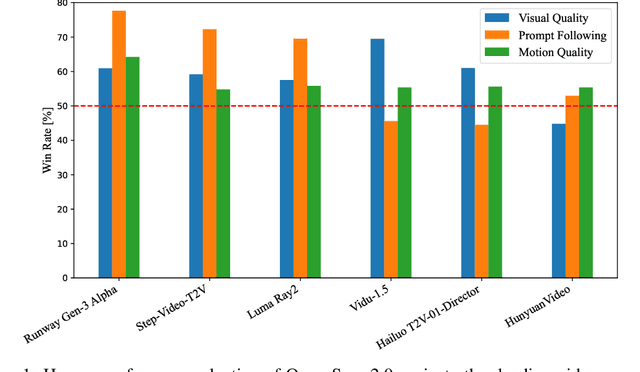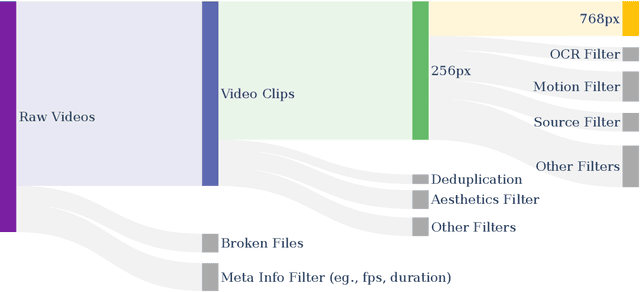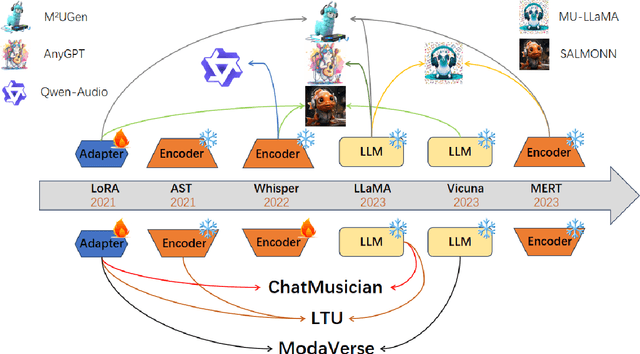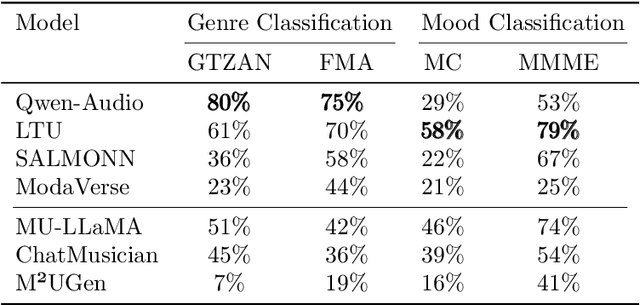Wenjun Li
Doc-Researcher: A Unified System for Multimodal Document Parsing and Deep Research
Oct 24, 2025Abstract:Deep Research systems have revolutionized how LLMs solve complex questions through iterative reasoning and evidence gathering. However, current systems remain fundamentally constrained to textual web data, overlooking the vast knowledge embedded in multimodal documents Processing such documents demands sophisticated parsing to preserve visual semantics (figures, tables, charts, and equations), intelligent chunking to maintain structural coherence, and adaptive retrieval across modalities, which are capabilities absent in existing systems. In response, we present Doc-Researcher, a unified system that bridges this gap through three integrated components: (i) deep multimodal parsing that preserves layout structure and visual semantics while creating multi-granular representations from chunk to document level, (ii) systematic retrieval architecture supporting text-only, vision-only, and hybrid paradigms with dynamic granularity selection, and (iii) iterative multi-agent workflows that decompose complex queries, progressively accumulate evidence, and synthesize comprehensive answers across documents and modalities. To enable rigorous evaluation, we introduce M4DocBench, the first benchmark for Multi-modal, Multi-hop, Multi-document, and Multi-turn deep research. Featuring 158 expert-annotated questions with complete evidence chains across 304 documents, M4DocBench tests capabilities that existing benchmarks cannot assess. Experiments demonstrate that Doc-Researcher achieves 50.6% accuracy, 3.4xbetter than state-of-the-art baselines, validating that effective document research requires not just better retrieval, but fundamentally deep parsing that preserve multimodal integrity and support iterative research. Our work establishes a new paradigm for conducting deep research on multimodal document collections.
Understanding R1-Zero-Like Training: A Critical Perspective
Mar 26, 2025Abstract:DeepSeek-R1-Zero has shown that reinforcement learning (RL) at scale can directly enhance the reasoning capabilities of LLMs without supervised fine-tuning. In this work, we critically examine R1-Zero-like training by analyzing its two core components: base models and RL. We investigate a wide range of base models, including DeepSeek-V3-Base, to understand how pretraining characteristics influence RL performance. Our analysis reveals that DeepSeek-V3-Base already exhibit ''Aha moment'', while Qwen2.5 base models demonstrate strong reasoning capabilities even without prompt templates, suggesting potential pretraining biases. Additionally, we identify an optimization bias in Group Relative Policy Optimization (GRPO), which artificially increases response length (especially for incorrect outputs) during training. To address this, we introduce Dr. GRPO, an unbiased optimization method that improves token efficiency while maintaining reasoning performance. Leveraging these insights, we present a minimalist R1-Zero recipe that achieves 43.3% accuracy on AIME 2024 with a 7B base model, establishing a new state-of-the-art. Our code is available at https://github.com/sail-sg/understand-r1-zero.
Open-Sora 2.0: Training a Commercial-Level Video Generation Model in $200k
Mar 12, 2025



Abstract:Video generation models have achieved remarkable progress in the past year. The quality of AI video continues to improve, but at the cost of larger model size, increased data quantity, and greater demand for training compute. In this report, we present Open-Sora 2.0, a commercial-level video generation model trained for only $200k. With this model, we demonstrate that the cost of training a top-performing video generation model is highly controllable. We detail all techniques that contribute to this efficiency breakthrough, including data curation, model architecture, training strategy, and system optimization. According to human evaluation results and VBench scores, Open-Sora 2.0 is comparable to global leading video generation models including the open-source HunyuanVideo and the closed-source Runway Gen-3 Alpha. By making Open-Sora 2.0 fully open-source, we aim to democratize access to advanced video generation technology, fostering broader innovation and creativity in content creation. All resources are publicly available at: https://github.com/hpcaitech/Open-Sora.
Adaptive Tool Use in Large Language Models with Meta-Cognition Trigger
Feb 18, 2025



Abstract:Large language models (LLMs) have shown remarkable emergent capabilities, transforming the execution of functional tasks by leveraging external tools for complex problems that require specialized processing or real-time data. While existing research expands LLMs access to diverse tools (e.g., program interpreters, search engines, weather/map apps), the necessity of using these tools is often overlooked, leading to indiscriminate tool invocation. This naive approach raises two key issues:(1) increased delays due to unnecessary tool calls, and (2) potential errors resulting from faulty interactions with external tools. In this paper, we introduce meta-cognition as a proxy for LLMs self-assessment of their capabilities, representing the model's awareness of its own limitations. Based on this, we propose MeCo, an adaptive decision-making strategy for external tool use. MeCo quantifies metacognitive scores by capturing high-level cognitive signals in the representation space, guiding when to invoke tools. Notably, MeCo is fine-tuning-free and incurs minimal cost. Our experiments show that MeCo accurately detects LLMs' internal cognitive signals and significantly improves tool-use decision-making across multiple base models and benchmarks.
Improving Environment Novelty Quantification for Effective Unsupervised Environment Design
Feb 08, 2025Abstract:Unsupervised Environment Design (UED) formalizes the problem of autocurricula through interactive training between a teacher agent and a student agent. The teacher generates new training environments with high learning potential, curating an adaptive curriculum that strengthens the student's ability to handle unseen scenarios. Existing UED methods mainly rely on regret, a metric that measures the difference between the agent's optimal and actual performance, to guide curriculum design. Regret-driven methods generate curricula that progressively increase environment complexity for the student but overlook environment novelty -- a critical element for enhancing an agent's generalizability. Measuring environment novelty is especially challenging due to the underspecified nature of environment parameters in UED, and existing approaches face significant limitations. To address this, this paper introduces the Coverage-based Evaluation of Novelty In Environment (CENIE) framework. CENIE proposes a scalable, domain-agnostic, and curriculum-aware approach to quantifying environment novelty by leveraging the student's state-action space coverage from previous curriculum experiences. We then propose an implementation of CENIE that models this coverage and measures environment novelty using Gaussian Mixture Models. By integrating both regret and novelty as complementary objectives for curriculum design, CENIE facilitates effective exploration across the state-action space while progressively increasing curriculum complexity. Empirical evaluations demonstrate that augmenting existing regret-based UED algorithms with CENIE achieves state-of-the-art performance across multiple benchmarks, underscoring the effectiveness of novelty-driven autocurricula for robust generalization.
A Survey of Foundation Models for Music Understanding
Sep 15, 2024



Abstract:Music is essential in daily life, fulfilling emotional and entertainment needs, and connecting us personally, socially, and culturally. A better understanding of music can enhance our emotions, cognitive skills, and cultural connections. The rapid advancement of artificial intelligence (AI) has introduced new ways to analyze music, aiming to replicate human understanding of music and provide related services. While the traditional models focused on audio features and simple tasks, the recent development of large language models (LLMs) and foundation models (FMs), which excel in various fields by integrating semantic information and demonstrating strong reasoning abilities, could capture complex musical features and patterns, integrate music with language and incorporate rich musical, emotional and psychological knowledge. Therefore, they have the potential in handling complex music understanding tasks from a semantic perspective, producing outputs closer to human perception. This work, to our best knowledge, is one of the early reviews of the intersection of AI techniques and music understanding. We investigated, analyzed, and tested recent large-scale music foundation models in respect of their music comprehension abilities. We also discussed their limitations and proposed possible future directions, offering insights for researchers in this field.
A Comprehensive Review of Multimodal Large Language Models: Performance and Challenges Across Different Tasks
Aug 02, 2024
Abstract:In an era defined by the explosive growth of data and rapid technological advancements, Multimodal Large Language Models (MLLMs) stand at the forefront of artificial intelligence (AI) systems. Designed to seamlessly integrate diverse data types-including text, images, videos, audio, and physiological sequences-MLLMs address the complexities of real-world applications far beyond the capabilities of single-modality systems. In this paper, we systematically sort out the applications of MLLM in multimodal tasks such as natural language, vision, and audio. We also provide a comparative analysis of the focus of different MLLMs in the tasks, and provide insights into the shortcomings of current MLLMs, and suggest potential directions for future research. Through these discussions, this paper hopes to provide valuable insights for the further development and application of MLLM.
Unlocking Large Language Model's Planning Capabilities with Maximum Diversity Fine-tuning
Jun 15, 2024Abstract:Large language models (LLMs) have demonstrated impressive task-solving capabilities, achieved through either prompting techniques or system designs. However, concerns have arisen regarding their proficiency in planning tasks, as they often struggle to generate valid plans. This paper investigates the impact of fine-tuning on LLMs' planning capabilities. Our findings indicate that LLMs can achieve good performance in planning through substantial (thousands of specific examples) fine-tuning. However, fine-tuning is associated with significant economic and computational costs. To address this challenge, we propose the Maximum Diversity Fine-Tuning (MDFT) strategy to improve the sample efficiency of fine-tuning in the planning domain. Specifically, our algorithm, referred to as MDFT-g, encodes the planning task instances with their graph representations and selects a subset of samples in the vector space that maximizes data diversity. We empirically demonstrate that MDFT-g consistently outperforms existing baselines at various scales across multiple benchmark domains.
Controllable Talking Face Generation by Implicit Facial Keypoints Editing
Jun 05, 2024Abstract:Audio-driven talking face generation has garnered significant interest within the domain of digital human research. Existing methods are encumbered by intricate model architectures that are intricately dependent on each other, complicating the process of re-editing image or video inputs. In this work, we present ControlTalk, a talking face generation method to control face expression deformation based on driven audio, which can construct the head pose and facial expression including lip motion for both single image or sequential video inputs in a unified manner. By utilizing a pre-trained video synthesis renderer and proposing the lightweight adaptation, ControlTalk achieves precise and naturalistic lip synchronization while enabling quantitative control over mouth opening shape. Our experiments show that our method is superior to state-of-the-art performance on widely used benchmarks, including HDTF and MEAD. The parameterized adaptation demonstrates remarkable generalization capabilities, effectively handling expression deformation across same-ID and cross-ID scenarios, and extending its utility to out-of-domain portraits, regardless of languages.
ODD: A Benchmark Dataset for the NLP-based Opioid Related Aberrant Behavior Detection
Jul 24, 2023



Abstract:Opioid related aberrant behaviors (ORAB) present novel risk factors for opioid overdose. Previously, ORAB have been mainly assessed by survey results and by monitoring drug administrations. Such methods however, cannot scale up and do not cover the entire spectrum of aberrant behaviors. On the other hand, ORAB are widely documented in electronic health record notes. This paper introduces a novel biomedical natural language processing benchmark dataset named ODD, for ORAB Detection Dataset. ODD is an expert-annotated dataset comprising of more than 750 publicly available EHR notes. ODD has been designed to identify ORAB from patients' EHR notes and classify them into nine categories; 1) Confirmed Aberrant Behavior, 2) Suggested Aberrant Behavior, 3) Opioids, 4) Indication, 5) Diagnosed opioid dependency, 6) Benzodiapines, 7) Medication Changes, 8) Central Nervous System-related, and 9) Social Determinants of Health. We explored two state-of-the-art natural language processing (NLP) models (finetuning pretrained language models and prompt-tuning approaches) to identify ORAB. Experimental results show that the prompt-tuning models outperformed the finetuning models in most cateogories and the gains were especially higher among uncommon categories (Suggested aberrant behavior, Diagnosed opioid dependency and Medication change). Although the best model achieved the highest 83.92% on area under precision recall curve, uncommon classes (Suggested Aberrant Behavior, Diagnosed Opioid Dependence, and Medication Change) still have a large room for performance improvement.
 Add to Chrome
Add to Chrome Add to Firefox
Add to Firefox Add to Edge
Add to Edge